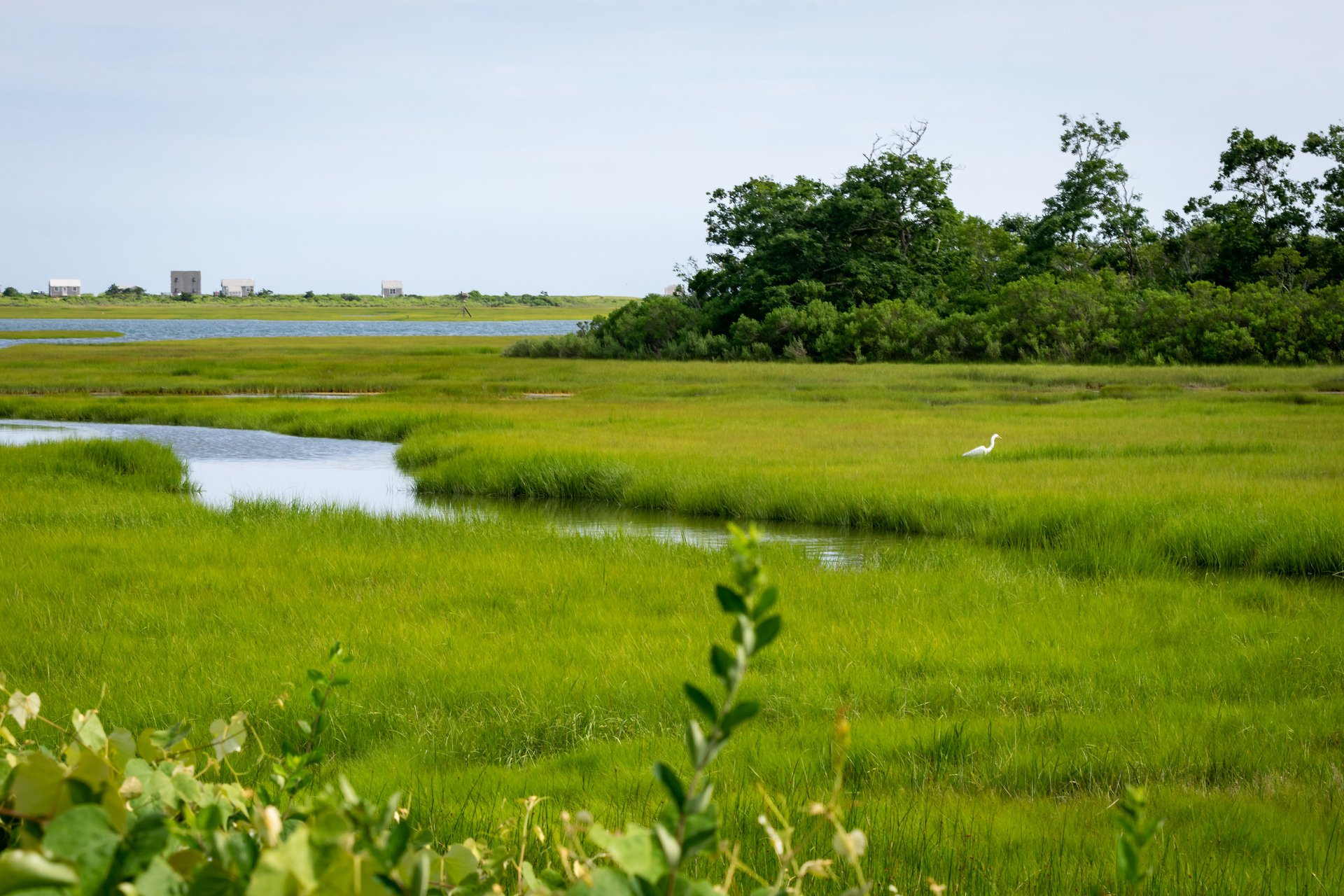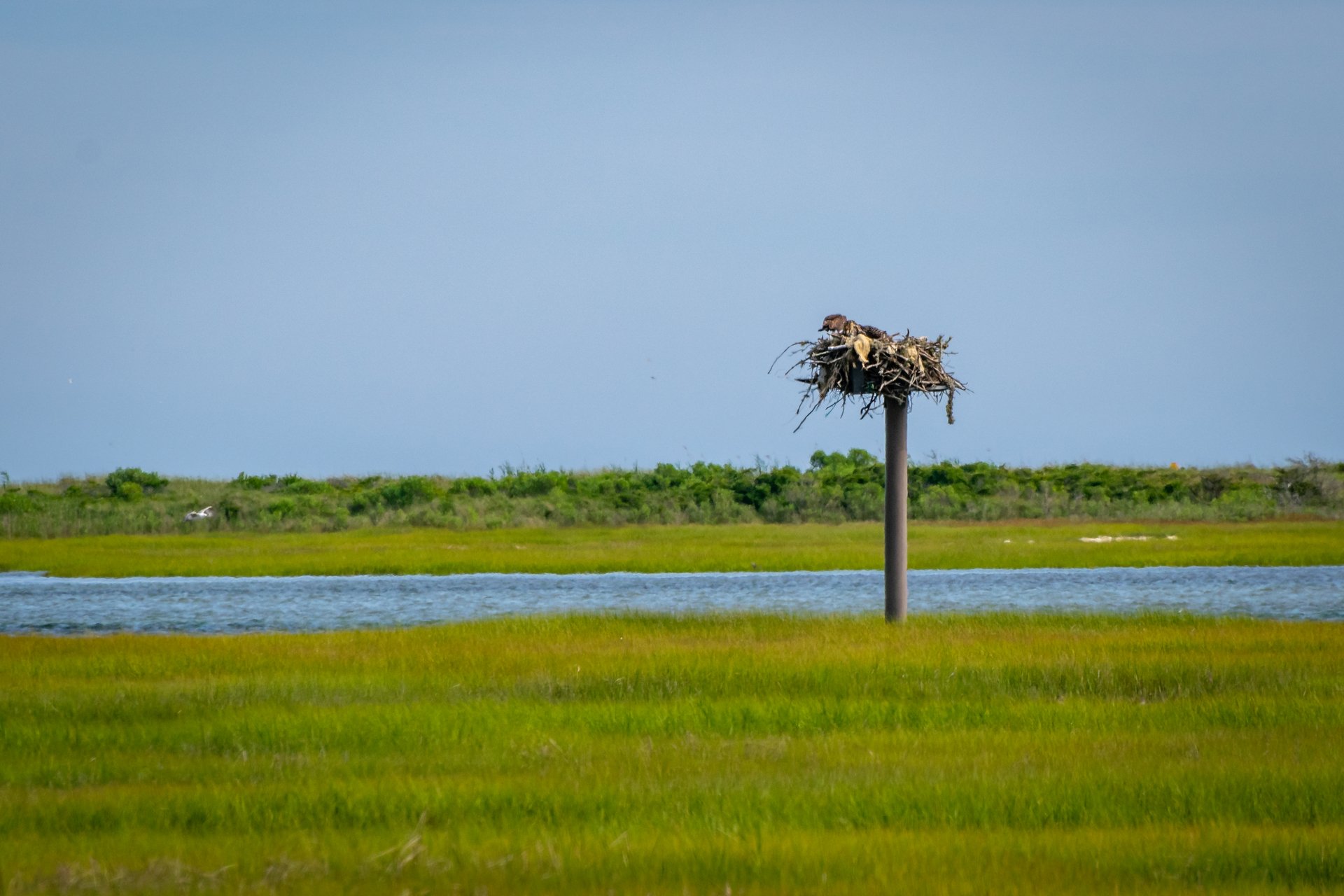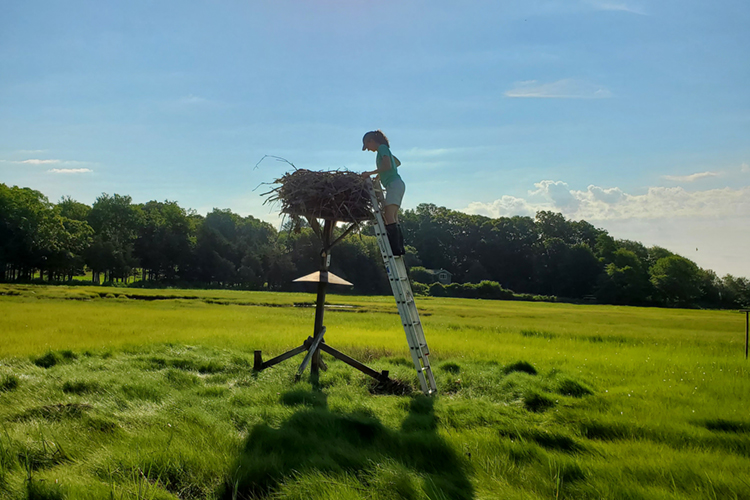Conservation Projects at Allens Pond
South Coast Osprey Project
Westport, Massachusetts, is home to one of the more significant breeding populations of Osprey in North America.
Since 2004, Allens Pond Wildlife Sanctuary, with the essential support of volunteers and partner organizations, annually monitors the breeding activity of 80 pairs of Osprey on nearly 100 nesting platforms in Westport and Dartmouth, MA. These platforms were installed beginning around 1965 by two local residents, Gil and Jo Fernandez, and willing property owners and Osprey friends.
Why Monitor Ospreys
As top predators (fish-eaters) in salt-marsh estuaries and nearby bay waters, Ospreys are an important barometer of change in our coastal environment. Ospreys also hunt in freshwater streams and ponds, particularly during the herring run season when they pick them out of fish ladders. Healthy, productive Ospreys reflect healthy, productive fisheries, which in turn mean productive estuaries and bay waters.
Given that the Westport River/Allens Pond landscape is a state-designated Important Bird Area in Massachusetts partly because of the significance of these raptors on the landscape, monitoring their success is a way to be good stewards of this natural resource.
Four main goals of the South Coast Osprey Project are:
- To determine the outcome of each pair’s breeding attempt and contribute these data to scientific research of our environment and this species.
- To maintain platforms
- To communicate the richness and vulnerability of our environment.
- To engage volunteers and students year-round, instilling the actions of stewardship and conservation.
How We Monitor
From April thru mid-July, nests are checked by staff and trained volunteers every few weeks to document success or failure at each stage of breeding (residency, incubation, hatch, and fledge).
- Early April: Our first look from roadside vantage points determines how many pairs have returned to nest and at what platforms. A few females will already be incubating this early.
- Two weeks later: We begin counting eggs at nests by either climbing a ladder up the platform or raising a mirror from below to reflect what is in the nest.
- Through May: Monitoring shifts to count chicks in the nest. At this time, storms cause some clutches to fail or chicks to die when males are challenged to feed their mate and brood and females are challenged to keep eggs or chicks warm and dry.
- Mid-June into July: When chicks have reached the age of 5 weeks, we get our last up-close look at them, band them, and count them as likely to fledge. From then on, we only observe them from a distance because if disturbed, they could very easily be spooked off the nest and perish without the skills to successfully fly.
Banding and GPS Tracking
In addition to nest monitoring, Allens Pond’s osprey team and partners band young nearly-fledged birds under the research permit of Manomet Center for Conservation Sciences. Banding fledglings and adults provides a long-term tool for understanding Osprey survival and fidelity to region and nest sites.
While useful in the aggregate and inexpensive compared to GPS technology, banding is not helpful for identifying free-flying birds as the engraved identification number on the aluminum band is very hard to observe in the field.
From 2009 to 2013, Allens Pond partnered with Rob Bierregaard of Ospreytrax.com to outfit eight local ospreys with GPS transmitters. The transmitters signaled where each bird was traveling from hour to hour and day to day, whether fishing in Rhode Island or migrating to Columbia. Some of the tidbits we learned are:
- The herring runs of early spring are critical food resources for our birds.
- After the herring run, breeding males have hunting ranges (viewed as polygons on the GPS map) that they stick pretty close to and that are distinct from one another.
- At night, males roost well away from the nest until the chicks approach fledgling when they’ll roost closer to the nest.
- The only juvenile we tracked went north to Canada in September before turning southbound.
- Our males wintered in Cuba, Columbia, Bahamas, Venezuela, and on the Bolivia/Brazil border.
- A storm propelled one returning osprey offshore in late March and while he survived, he lost almost a week in recovery and also the platform and female he was returning to because a different male got there first.
- Our birds shook off one transmitter, fed a Great Horned Owl, ate all winter at a fish farm before getting shot, faced unknown odds over water, and faced unknown odds in South America.
If you would like to learn more, please contact us.
Please Note: This work is performed with special permits. The general public is not allowed to approach, harass, or capture any Osprey or other raptor.
Volunteer
We're always looking for people who can contribute their time, skills, and effort to help the South Coast Osprey Project with the following:
- Monitor the nesting platforms from land by using your own spotting scope and sending us your observations. (March through September, ongoing)
- Build new platforms according to our interchangeable design to have a stockpile for fast deployment during the narrow window of maintenance; we provide the specifications. (Year-round)
- Participate in workdays to repair or replace old platforms in the field—especially if you have a boat! (March, April, September, October)
- Help our outreach team at local events and through various communication channels. (Year-round)
To get started as a volunteer, please complete our Volunteer Interest Form. Once we receive your information, we'll be in touch about matching you with the right volunteer opportunity based on your schedule.
Donate
By making a donation to the South Coast Osprey Project, you will join a group of important supporters who make it possible for us to:
- Maintain the platforms so they continue to support the next generation of Osprey.
- Monitor breeding successes and failures so we can stay abreast of important threats and trends.
- Contribute to the 50+ year dataset that Gil and Jo Fernandez began as volunteers for US Fish & Wildlife Service, Manomet, and Mass Audubon.
- Connect with researchers to maximize scientific advancement for the benefit of these birds and the coastal environment.
- Inspire young professionals and conduct community outreach to raise awareness about and commitment to healthy habitats and robust wildlife populations.





